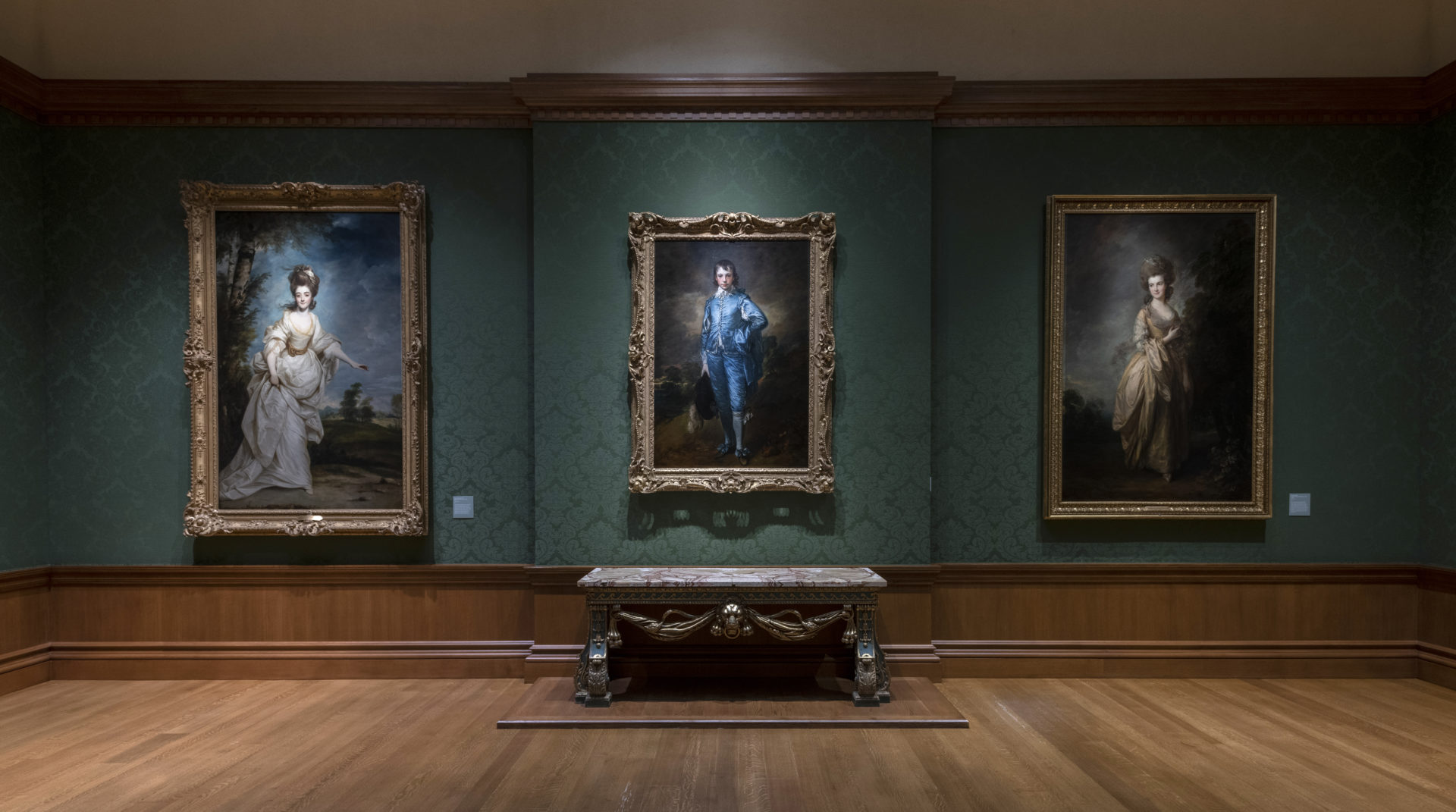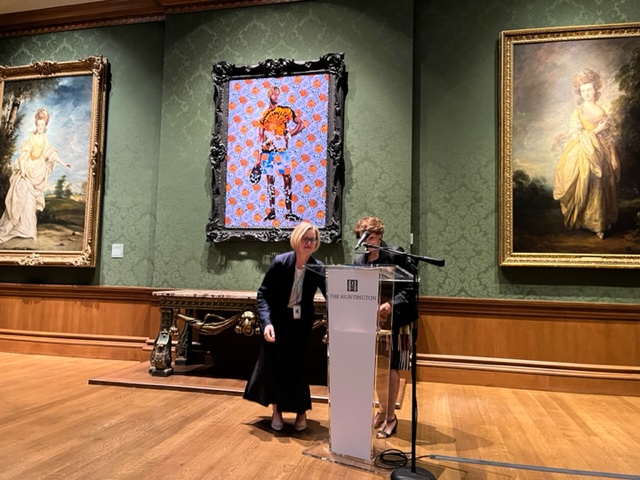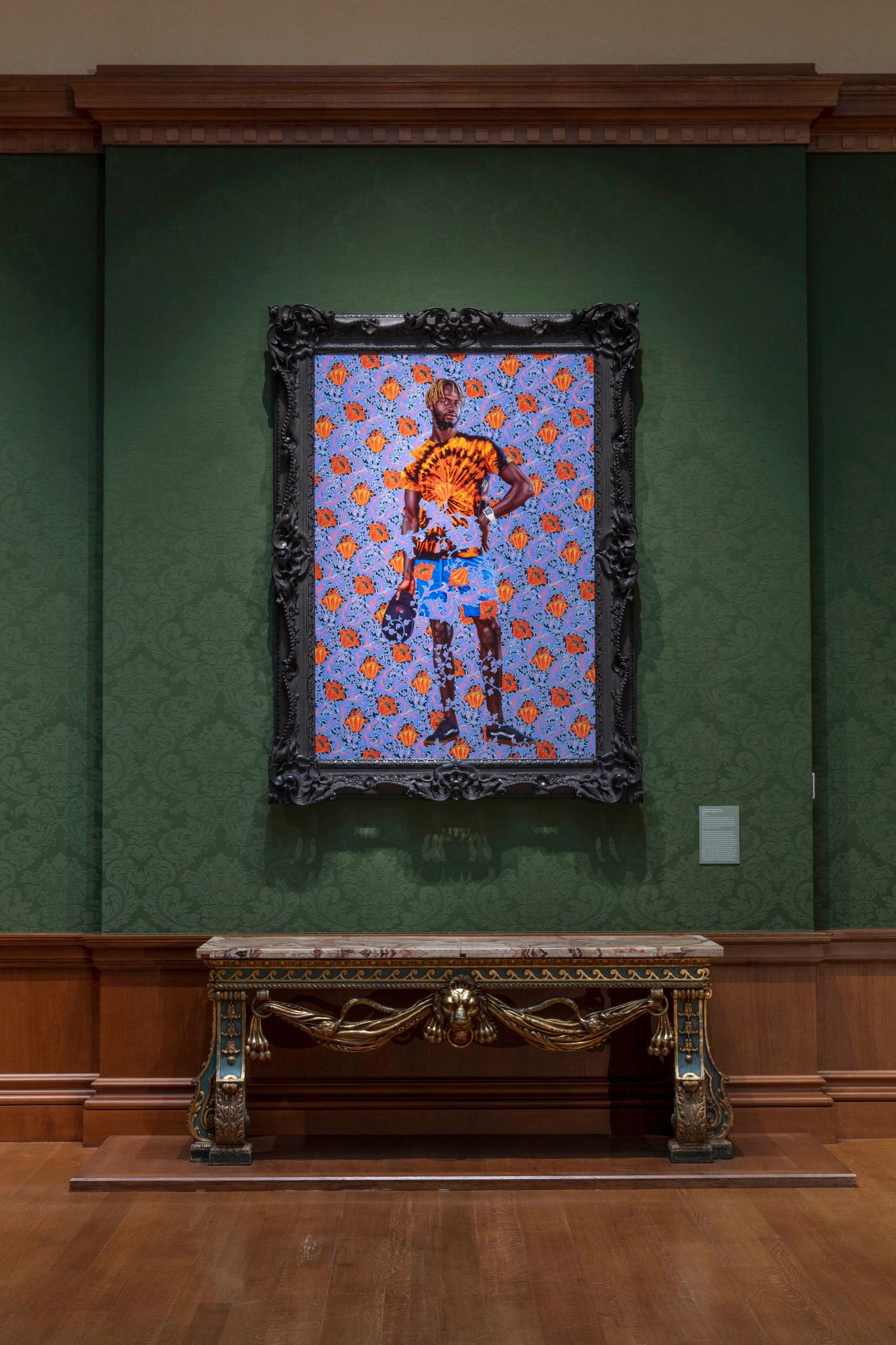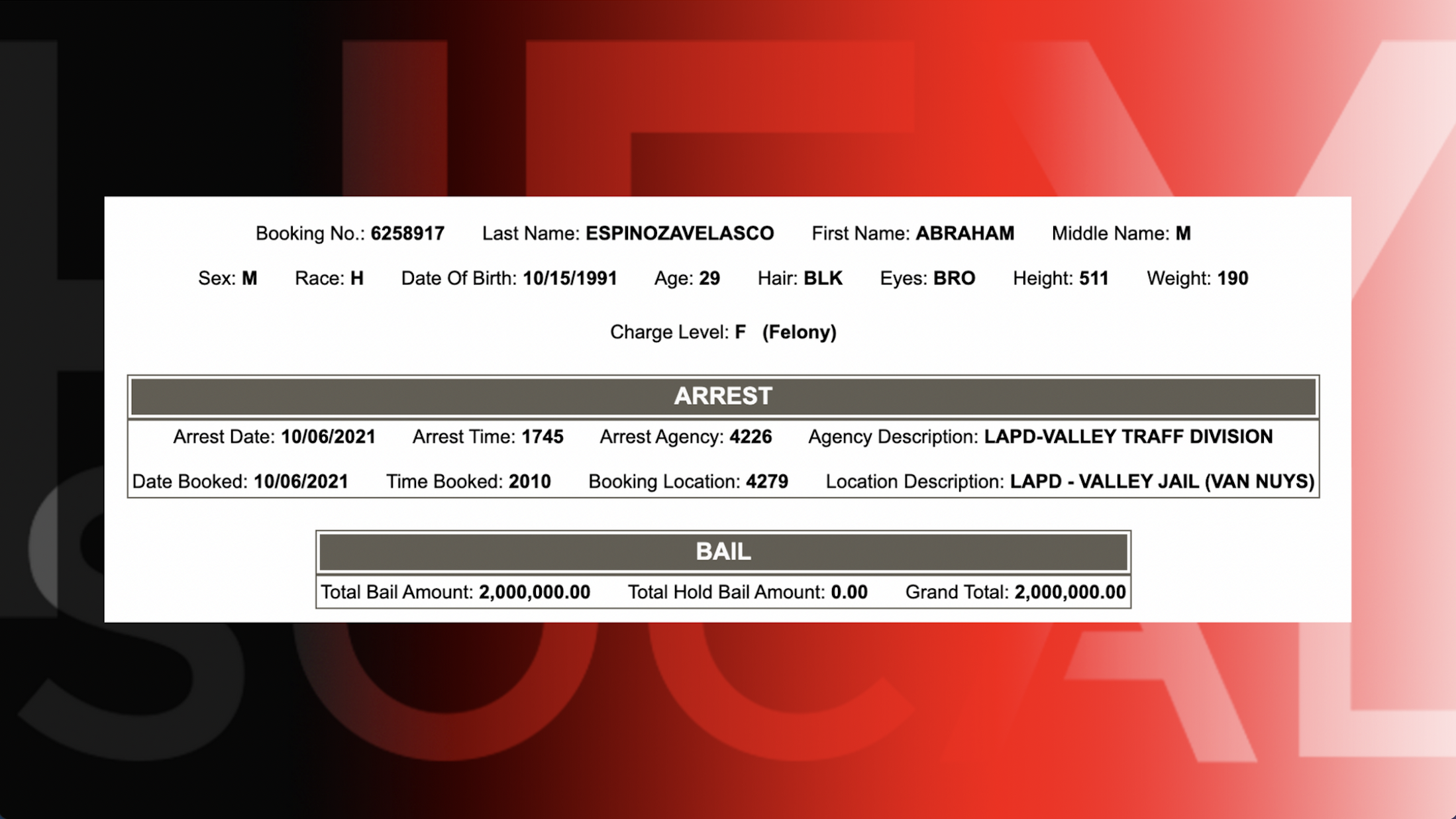On Saturday, Oct. 2, 2021, The Huntington Library, Art Museum, and Botanical Gardens (The Huntington) unveiled Kehinde Wiley’s “A Portrait of a Gentleman,” a modern-day interpretation of Thomas Gainsborough’s magnificent 18th century masterpiece. It will be on display at the Thornton Portrait Gallery as part of an exhibition which includes other paintings hanging outside in the north passage. (Thomas Lawrence’s “Pinkie,” another renowned treasure, has been moved there but will be back in the portrait gallery next year.)
Commissioned by The Huntington to celebrate the 100th anniversary of “The Blue Boy’s” acquisition by Henry and Arabella Huntington, “A Portrait of a Young Gentleman” will be in the museum’s permanent collection and visitors can still view it after the show ends on Jan. 3, 2022.
Wiley has famously talked about The Huntington having a major role in his formative years. “I loved The Huntington’s galleries; the paintings by Joshua Reynolds, Thomas Gainsborough, and John Constable were some of my favorites. I was taken by their imagery, their sheer spectacle, and, of course, their beauty. When I started painting, I started looking at their technical proficiency – the manipulation of paint, color, and composition. These portraits are hyperreal, with the detail on the face finely crafted, and the brushwork, the clothing, and the landscape fluid and playful. Since I felt somewhat removed from the imagery – personally and culturally – I took a scientific approach and had an aesthetic fascination with these paintings. That distance gave me a removed freedom. Later, I started thinking about issues of desire, objectification, and fantasy in portraiture and, of course, colonialism.”
Karen Lawrence, president of The Huntington, speaking to the press during a preview one hour before the public viewing remarks, “We’ve long admired Kehinde Wiley’s work and the idea of engaging him with us at The Huntington has been in the works and under development for a few years. It is impossible to communicate how thrilling this moment is for us. We often think about influence as a one-way street: the past affecting the present. But as these two portraits of a ‘young gentleman’ face each other across this gallery and across 250 years of history, we can recognize that the present affects the past – the present powerfully reconfigures the past.”
“Kehinde Wiley’s magnificent portrait does more than engage with Gainsborough’s 18th century masterpiece ‘The Blue Boy’ and the other works on display in this room,” continues Lawrence. “It really brings Wiley full circle to a place that he himself has said influences his art practice greatly. For it was to The Huntington that he came as a child with his mother and spent much time looking at these oversized portraits and their grand landscapes. He was impressed in two ways – by the sheer beauty of the brushstrokes and the grandeur of the composition – as much as by what was missing – the lack of representation of anyone who looked like himself.
“When we celebrated our centennial at The Huntington in 2019 we committed ourselves to re-examining the past and re-imagining the future. In this sense, our archives and collections are alive. Kehinde Wiley’s painting changes the Grand Manner portraits of the English nobility surrounding us.”
The themes of past and present are further explored when Christina Nielsen, director of The Huntington Art Museum, tells how Gainsborough – who preferred landscapes – became a portrait painter because it was the more lucrative career, how he broke into the London art market, and then gained national prominence.

“Gainsborough called upon the art of artists before him – van Dyck, in particular – and produced ‘A Portrait of a Young Gentleman,’ as he named it, and displayed it in 1770 at the Royal Academy Exhibition. It was a show stopper. He threw everything at it, including enormously expensive pigments: lapis, azurite, cobalt, indigo. He tweaked artistic conventions and went against reigning art theory of the day, which says blue should not provide a compositional methodology for a painting. It was a sensational success and artists of the time renamed Gainsborough’s painting ‘Blue Boy.’”
Nielsen expands, “The Huntington Art Museum has the enormous responsibility of being the steward of Gainsborough’s ‘Blue Boy.’ We are the keeper of this work for present visitors and future generations. It is one of the most influential and beloved master paintings in an American collection and we feel it very keenly on a daily basis. In the 250 years since its existence, it has influenced people like Whistler, Rauschenberg, now Wiley, among many others. It has absolutely sparked public imagination. It was on Cadbury tins in Great Britain before coming to the United States and it was in 11 exhibitions across the 19th century. It was reproduced and hanging on the walls of most British homes before it was purchased by Henry and Arabella Huntington in 1921.”
“And as we celebrate the 100th anniversary of its coming here, we also know how beloved it has become not only for British audiences,” Nielsen says further. “It is an American icon thanks to popular culture that emanates from California, specifically the movie industry. Stars from Marlena Dietrich to Jamie Foxx have dressed up and appeared in Hollywood movies as the ‘Blue Boy.’ It’s iconic on so many levels it’s hard not to sound hyperbolic. And if you have a painting like that in your collection, how do you respond for 21st century audiences?”
“There are few living artists today who could respond to the call like the one emanating from Gainsborough’s ‘Blue Boy.’ Kehinde Wiley answered the phone and responded magnificently. He is a painter who singlehandedly has changed the conversation about portraiture in the country, the power of representation, and the representation of power,” declares Nielsen.
And because everything today is global, ‘A Portrait of a Young Gentleman’ corresponds in its span. The model looks like someone every Angeleno can relate to – a surfer dude wearing a tie-dyed tee shirt, neon blue shorts, and Vans shoes, standing in a field of bright orange California poppies. Yet, he is anonymous. And there is universality in anonymity, according to Nielsen.

Wiley began working on the portrait during lockdown in Senegal where his Black Rock Senegal multidisciplinary artist-in-residence program is based, so Nielsen thinks his model is a young man from Dakar. The painting moved to his Beijing studio and then to his New York atelier early this summer. It then came to Los Angeles where it was placed in a train with an exact replica of the 18th century frame that The Huntington purchased a decade or so ago for the ‘Blue Boy.’ The frame was hand-carved in Nicaragua.
Seeing Wiley’s “A Portrait of a Young Gentleman” occupying the space that has been “The Blue Boy’s” pride of place in the last hundred years might come as a surprise to some. It seems like a dissonance from all the paintings of properly-attired personalities in the gallery.
“Some of the Grand Manner sitters are in clothes of the day. Even in the 18th century, fashion was an incredibly important marker,” Nielsen explains. “Kehinde Wiley inserts black bodies into historical stories, and what these people would be wearing today. He’s also very aware of fashion and high fashion; these choices are all incredibly deliberate and conscious. The portraits right now face each other in the characteristic gesture. The details in the Wiley speak to the contemporary.
“All art was once contemporary and Gainsborough’s was revolutionary in his day and was the catalyst for his fellow artists and visitors to that original Royal Academy show. I imagine this will feel catalytic. I know how I felt when I walked into this room and saw it on the wall. I can also say that several days in, I have fully metabolized it and now it feels like it’s always been here. You can’t look at it without thinking of them, you can’t look at them without feeling its presence. It’s incredibly exciting the range of conversations that this will open up for our audiences and I imagine, as always, art will elicit responses across the whole spectrum. It will take time for some people and some will immediately just feel the joy and exuberance.”
Lawrence says, “Kehinde’s portrait of Barack Obama for the National Portrait Gallery transformed everyone’s thought about presidential portraiture – the Grand Manner genre of presidential portrait was stunningly interrupted. And with that of Barack Obama’s added with all the white faces, you could predict how this will enter into the canon. The significance will be great.
“We wanted The Huntington to make invitations to re-interpret cultural practice as well as our historical and literary archives and collections in the library. For contemporary practitioners to activate, motivate, respond to what we have because otherwise, what’s the point? We’ve made that invitation and I think that the audiences for the Huntington will come here and see the continuity of past, present, and future, and embrace that. What is unexpected? What are the different voices? These are opportunities that we want to take. I’m speaking for myself and Christina and we’re absolutely thrilled with what Wiley has chosen to do.”







